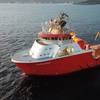By Mass Communication Specialist 1st Class Jeannette Bowles, USS Abraham Lincoln Public Affairs
Over the course of the last nine months, USS Abraham Lincoln (CVN 72) underwent several alterations, upgrades and installments, culminating in thousands of man hours and millions of dollars during its Dry-dock Planned Incremental Availability (DPIA) at Puget Sound Naval Shipyard, Bremerton, Wash.
As Lincoln headed back to sea, the DPIA came to a close on a high note June 26.
“From a ship’s force work package perspective, the DPIA was a resounding success and greatly exceeded all expectations,†said Lt. Cmdr. Jim Pyle, Lincoln’s maintenance manager.
The $260m overhaul and improvements to Lincoln were the combined effort of Lincoln’s Sailors and Puget Sound Naval Shipyard and Todd Pacific Shipyard, who were the primary contractors on the job.
Pyle said some of the bigger projects undertaken included laying down non-skid on the flight deck, a service change to catapults (CATs) 2 and 3, installation of the Rolling Airframe Missile (RAM) system, work on the propulsion plants, underwater hull paint touch up, and a capacity upgrade of the ship’s aircraft elevators.
“The biggest part of the package was preserving the feed and potable water tanks,†Pyle said. “That’s the reason we went into dry dock.â€
Aside from the nuclear production work, Pyle said the work on catapults 2 and 3 took the longest to complete.
“We installed ‘non-interlocking’ trough covers on CATs 2 and 3,†Pyle said. “This allows maintenance on the catapults to be done at a specific location without having to lift all the trough covers.â€
Pyle said at the height of the maintenance period, there were more than 2,000 shipyard workers and contractors on board. Throughout the DPIA, just over 369,000 man-days were invested in getting Lincoln back to full sea-strength capability.
Todd Pacific Shipyard and its subcontractors invested 36,549 man-days, Puget Sound Naval Shipyard worked 246,762 man-days, the Alteration Installation teams provided 25,000 man-days, and Lincoln Sailors worked 61,000 man-days to get Lincoln back on track.
Pyle said the ship’s force had an expectation and met it during the DPIA, and that helped Lincoln and civilian contractors reach their goal.
Pyle said the ship planned what work needed to be done and then chose the teams they needed to complete the work.
“We worked with the command master chief to come up with over 500 people who were sent TAD (temporary assigned duty) to teams to accomplish all the work,†Pyle said.
According to Pyle, there were 12 teams of Sailors throughout DPIA who worked on Lincoln. Some of the teams included the habitability team which modified 10 berthings and 800 racks; the deck team which tiled 311 decks; the door team which completed 317 door jobs; the paint team who painted 408 spaces; the vent team which cleaned 102 vent ducts around the ship; and the rehabitability team which fixed 79 miscellaneous berthing/head discrepancies.
Each member of the fire watch team ensured the safety of the job they were assigned to, the shipyard worker and the space that was being worked in. It was their responsibility to stand by during welding projects and put out any fires that may be caused by sparks from the welding. The fire watch team provided 175 Sailors for fire watches for Naval Shipyard work.
With in excess of 369,000 man-days and a $260m cost, which included $11m for transportation costs to and from homeport in Everett, Wash., Lincoln’s DPIA came to a close.
The maintenance and alteration work package for the availability was significantly larger and more complex than prior six-month aircraft carrier availabilities. This availability included extensive tank preservation, catapult repairs, and upgrades to the navigation equipment and to the ship’s defense systems, which led to an extended maintenance period.
Pyle said he attributed the successful DPIA to those who worked on Lincoln.
“The ship had to manage and coordinate all of the activities to complete the amount of work that it did,†Pyle said. “It’s a tribute to the zone managers and the Sailors and their respective teams and work centers and their ability to work with and around all the other work going on, that we’re able to accomplish all the work we had planned.â€
The next availability is scheduled to take place in May 2009.
Featured videos

Tracking Foreign Vessels Working in the U.S. Jones Act Market

Inside the Electrified Truckable Tug

Inmarsat Enhances Service to Drive Digitalization
Subscribe for
Maritime Reporter E-News
Maritime Reporter E-News is the maritime industry's largest circulation and most authoritative ENews Service, delivered to your Email five times per week









